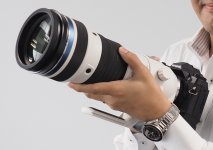Just tripped over a stegosaurus,
Cameras lasting a long time was the norm before digital crept in. My 1954 Leica M3 is still a viable photographic item. Before the digital revolution, cameras seemed to last forever.
My OM1s might have had a problem when mercury batteries were phased out, but Olympus brought out a conversion kit to take silver cells that their service agents fitted the next time your camera was serviced. So my earliest OM had about a 30 year life, taken all together over that time I had acquired 3 OM-1s, 2 OM-2s and an OM4ti + a lot of lenses mostly second hand, but brought up to new standard at their first service. They went when I got my first E-1 kit.
For me the biggest difference was that people printed everything, in fact I did a lot of photo recovery work of stuff going back to glass plates from the 19th century. Now most folks don't bother and possibly future generations will have no idea what great granny looked like.
What does all this prove? Things change over time, I used to be able to buy scrap lenses and cameras and rebuild them - the same with cars. Modern manufacturing doesn't need consumers with much in the way of skills. Manufacturers even consider repair of expensive kit uneconomic in many cases.
The birding community has benefited from these technological advances and still has the tools it needs to carry on in its various forms, concentrating more on the birds and allowing more people greater access to useful tools, rather than the technology (unless it interests you).
We will survive whatever happens with Olympus, but I must admit I miss the horse that our grocer used to pull his cart of fruit and veg to sell at the door to his housewife customers in South London when I was little. The Tescos van is far less fun.
In those days, there were next to no cars around but smogs and pollution were worse and killed many more people every winter. The past does have its downsides as well. (Pity about Covid 19 - sort of destroys that argument!)








